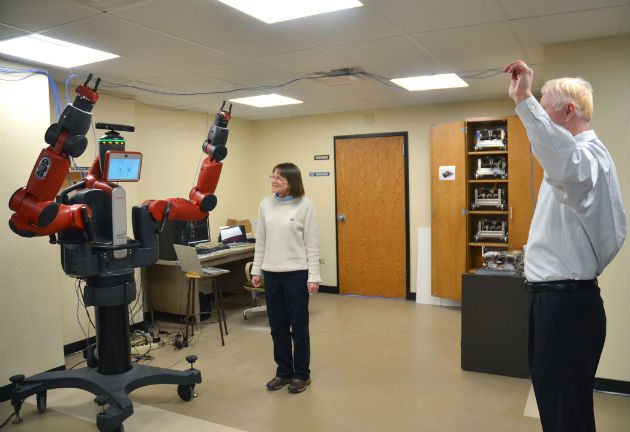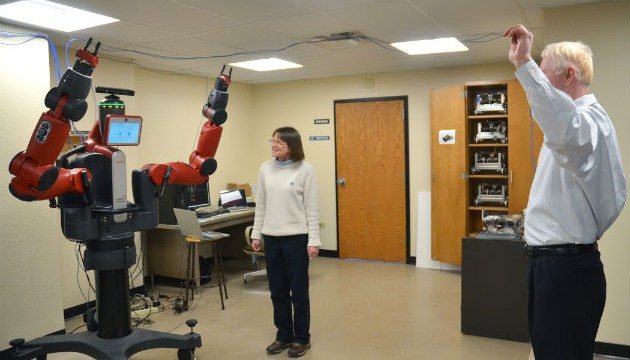
UNIVERSITY OF WYOMING — For the past two semesters, Debbie Kretzchmar has met with a new friend in a small lab in the University of Wyoming’s Engineering Building. The nontraditional UW student, majoring in computer science, works with Baxter on his motor skills, which includes arm movement and gripping with his hands. 
Baxter isn’t your ordinary friend, though. He is a robot.
Housed in UW’s Electrical and Computer Engineering Department (ECE), Baxter is big and red, and looks pretty bad. But, he looks friendly due to his big eyes that appear on an LCD screen that graces his face.
Kretzchmar has worked with the robot since the fall semester. She is exploring using Baxter as a coach for patients undergoing physical therapy while her husband, James, who is enrolled in an independent study in the ECE department, assists with demonstrations and testing of specific routines.
Baxter is outfitted with an assortment of gizmos. An Xbox 360 camera is perched atop his head. His face doubles as an LCD screen. Each of his arms includes seven joints for flexibility; he can pick up things with his hands or “grippers”; and even has a face with big wide eyes that gives him a distinct personality. So he can talk, Baxter has a speaker attached to the back of his head. The big red guy also has cameras and infrared sensors in each of his hands.
During the demonstration, Debbie Kretzchmar ran the computer program while James stood in front of Baxter, and slowly moved his arms and hands. Baxter followed along and mimicked the movements.
Kretzchmar says the demonstration provides a glimpse into Baxter’s capabilities.
“With the program I’m working on, I want to see if Baxter can be used as a coach. This particular demo shows that Baxter can follow or track what a human is doing,” she says. “It (robot) may be used at some point if a person was doing therapy for their arms. Baxter could follow their movements and provide encouragement by ‘speaking’ and displaying a message or ‘happy face’ on his LCD screen.”
Because Wyoming’s population is so spread and remote, telemedicine is an avenue that can be pursued further, Kretzchmar says. With telemedicine, a patient could receive therapy from a physical therapist or specialist hundreds of miles away.
“If you have a video conference setup, the therapist can watch, remotely, what the patient is doing,” she says. “Using external sensors and computer vision, Baxter could provide measurements on how much a person can lift their arm or turn a door knob. These measurements could be used to track progress.”
Baxter is safe to use around people. For example, if the robot’s arms came down and made contact with a person, Baxter’s motors would stop automatically.
“He has a lot of functionality that will make it easier for us to develop programs that can assist people,” she says.
Kretzchmar says she became aware of Baxter last spring. She had heard about the robot housed in the ECE and inquired about it. An engineering student offered to show her a demo of the robot.
Suresh Muknallipatna, a UW professor of electrical and computer engineering, says Kretzchmar had the right background and interest for working with Baxter.
“I and Professor (Robert) Kubichek were advertising for a student interested in robotics, programming and medicine to conduct research with Baxter, specifically to use Baxter as a substitute physical therapist,” Muknallipatna explains. “Debbie, being a nontraditional student, satisfies all of the above requirements.
“Kretzchmar previously was a medical doctor and currently is pursuing an undergraduate degree in computer science at UW,” he continues. “The background in medicine, along with her interest in programming and robotics, allowed us to provide Debbie an opportunity to conduct research with Baxter.”
Kretzchmar thanks both professors for the research opportunity.
“You don’t get these opportunities often as an undergraduate. There is so much potential for using Baxter as a teaching and research platform in electrical engineering and computer science,” Kretzchmar says. “It would be great to get more students involved in research. The more people we get involved, the better.”


